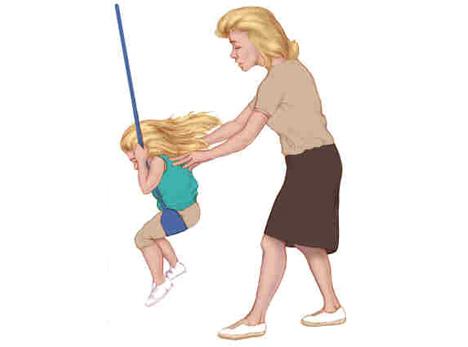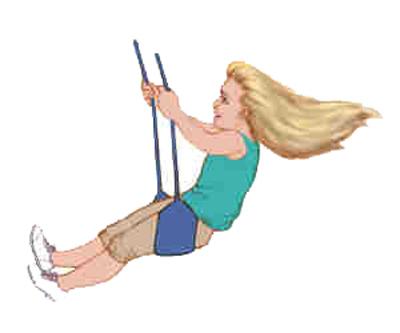Active Hearing Improves Frequency Selectivity

The end result of having outer hair cell electromotility is that we are able to discriminate between sounds that are very close in frequency. The reason for this may be easily understood by considering a simple children's swing. A playground swing is a mechanically tuned system that we are all familiar with. This fact is known to any parent who has pushed a child on a swing. The frequency of the system is determined by the length of the rope. The tuning of the system is best appreciated when you attempt to push at a frequency other than that determined by the natural frequency of the swing. If you attempt to push at a different frequency you know that the system fights against you and you have to exert considerably more energy if you really want it to move at a different frequency. A child sitting passively on a swing is an example of a passive in contrast to an active system.
As shown in Figure 8, a playground swing is a simple example of mechanical frequency selectivity with a passive system. The swing moves back and forth at a frequency that is determined by the length of the rope. The parent can make the swing move at a different frequency by exerting considerably more effort than pushing at the natural frequency.
Active Tuning

In order to understand what is meant by an active system you need only recall your own early experiences on a swing. After a short time you learned that you could make the swing to go higher and higher by pumping energy into the system through a combination of kicking your legs and tilting your upper body. Not only could you make the swing go very high but you probably experimented with kicking at a frequency other than the natural (passive) best frequency. When you did you found that you rapidly suppressed the magnitude of the swing. The new "active" system with you pumping had become effectively more narrowly tuned than the original system in which you just sat on the swing.
One way to imagine the cochlea is to envision a row of 3,000 swings that have progressively longer ropes and heavier children as you move to the right. Each swing has a preferred frequency that is lower than the swing to the left. The parents behind each child are equivalent to sound vibrations and if the children do not pump the entire set of swings is equivalent to a dead cochlea with relatively poor frequency selectivity. If the children pump the set of swings is now equivalent to a living or active cochlea with greatly improved frequency selectivity.
The role of the outer hair cells in hearing is both sensory and mechanical. When the organ of Corti begins to vibrate in response to the incoming sound, each hair cell will sense the vibration through the bending of its stereocilia. The bending results in a change in the outer hair cell's internal electrical potential which drives electromotility. If the resulting mechanical force is at the natural frequency of that portion of the cochlea then the magnitude of the vibration will increase. If the electomotile force is at a different frequency, the vibrations will decrease. The system now has greater sensitivity and frequency selectivity than when the outer hair cells are missing or damaged. The refined mechanical vibrations of the organ of Corti are transmitted to the inner hair cells which excite the 8th nerve fibers at their base and tell the central nervous system that there is energy at a specific frequency in the sound entering the ear. One consequence of having an active system is that oscillations can occur even when no energy is coming into the system from the outside. This happens in the cochlea and the resulting sound vibrations can be measured in the ear canal. These are called spontaneous otoacoustic emissions and are only observed in living ears. Measuring otoacoustic emissions has become an important diagnostic tool for determining if outer hair cells are working.
As shown in Figure 9 above, active tuning is achieved when the child pumps energy into the system. When the pumping is done at the natural frequency and at the correct time in the cycle the swing goes higher and tuning is improved. The improved tuning is best appreciated by attempting to pump at a frequency that is different than the natural frequency. In contrast with the parent pushing, no amount of pumping will make the swing move at the new frequency, in fact the magnitude of the swinging rapidly decreases. This ability to narrow the range of frequencies at which the swing will oscillate is equivalent to what the outer hair cell does in hearing.
Next chapter: Regeneration - The Problems of Reorganizing and Rewiring
Return to the table of contents of How the Ear Works







